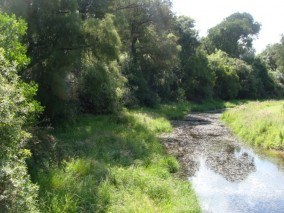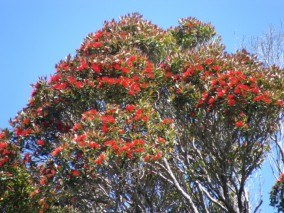The following information focuses on the lowland forest remnants of the Southland Plains. These are most commonly involved in restoration projects. Find out about the different types of forest remnants found in Southland today and what’s best to plant in each.
Types of forest
There are three main types of forest found in the Southland Plains area today:
- Lowland podocarp-broadleaf remnants.
- Coastal hardwood-podocarp forest of the Bluff-Omaui area.
- Totara and mixed podocarp forest of the Otatara area.
1. Lowland podocarp-broadleaf remnants
Remnants of lowland forest can be found throughout the Southland Plains. They are dominated by:
- Podocarps (native conifers), such as kahikatea, matai and rimu
- Broadleaves, such as kamahi and pokaka.
Check out the lowland forest remnants in Invercargill. They are regionally important as they represent examples of what lowland forests in Southland used to be like.
You can visit forest remnants at:
- Thomsons Bush
- Anderson Park
- Kew Bush (at Kew Hospital)
- Seaward Bush
Lowland podocarp-broadleaf remnants can be grouped into three main types:
Valley floor swamp forest Kahikatea Forest Thomsons Bush Invercargill
Kahikatea Forest Thomsons Bush Invercargill
Look for these along valley floors and flood plains. This type of forest can tolerate prolonged wet spells and consists of mainly tall kahikatea, with some pokaka and matai.
See good examples of valley floor swamp forest at Thomsons Bush, Kew Bush in Invercargill and Turnbulls Bush at Tussock Creek.
Mixed podocarp forest Forest Hill
Forest Hill
This is the most common forest type growing on flat land and gentle hill slopes. Here you’ll mainly find matai in the canopy, with some kahikatea, totara, rimu, miro, kamahi and pokaka. Exactly what you’ll find in each forest remnant will depend on specific site conditions.
Visit Seaward Bush and Forest Hill Scenic Reserve for great examples of mixed podocarp forest.
Riparian forest Riparian Forest at Thomsons Bush Invercargill
Riparian Forest at Thomsons Bush Invercargill
Few good examples of riparian forest remain in the Southland Plains. They would have once flourished on the rich alluvial soils edging watercourses throughout the Plains, however there are few left. Riparian forest is characterized by kowhai, lowland ribbonwood and kaikomako, usually with some matai, totara and other taller forest trees.
Check out Thomsons Bush in Invercargill and the plains around Winton Channel (for example, Kowhai Reach at Kauana), for remaining examples of riparian forest
2. Coastal hardwood-podocarp forest
At the southernmost tip of the South Island, the Bluff-Omaui area of Invercargill has a series of forest remnants which are regarded as being nationally important.  Rata Forest at Bluff HillThese coastal hardwood-podocarp forests are more similar to the forests of Stewart Island than the forests of the Invercargill District. You’ll find a mixture of rimu, miro, rata and kamahi growing in coastal hardwood-podocarp forest.
Rata Forest at Bluff HillThese coastal hardwood-podocarp forests are more similar to the forests of Stewart Island than the forests of the Invercargill District. You’ll find a mixture of rimu, miro, rata and kamahi growing in coastal hardwood-podocarp forest.
View the native forest areas of Bluff by walking along some of the Bluff Hill tracks, the Millennium track, the Topuni track, the Glory track and the Foveaux Walkway.
3. Totara and mixed podocarp forest Totara Forest at Daffodil Bay, Sandy Point, Invercargill
Totara Forest at Daffodil Bay, Sandy Point, Invercargill
The bush areas in Otatara-Sandy Point are dominated by podocarps (native conifers), including totara and matai. This type of bush is known as ‘coastal sand dune forest’ and is one of the most threatened forest types in the country. The Otatara-Sandy Point area contains the best remaining example of coastal totara and totara-matai sand dune forests in the whole of New Zealand – making it a very special place!
Unfortunately, like the rest of New Zealand, this area has undergone significant changes over the last 150 years. Just 20% of the bush cover present in Otatara in 1865 exists today. Much of this is now isolated due to clearance of land for farming, recreation and residential areas.
Check out the bush remnants in the Otatara/Sandy Point area at the following, which have public access tracks:
- Otatara Scenic Reserve (mixed podocarp)
- Bowman’s Bush (mixed podocarp)
- Kilmock Bush (totara forest)
- Daffodil Bay (totara forest)
- Bushy Point (Rance and Gamble QEII Covenants - mixed podocarp)
Forest restoration
 Restoration area at RancesNatural forest habitats are very diverse and complex. It is difficult to reproduce nature, so the best we can do is to protect what already exists and speed up the process of recovery from damage. Your forest restoration project may involve restoring a forest damaged by logging or grazing, or creating a new forest habitat from scratch (from a grass paddock).
Restoration area at RancesNatural forest habitats are very diverse and complex. It is difficult to reproduce nature, so the best we can do is to protect what already exists and speed up the process of recovery from damage. Your forest restoration project may involve restoring a forest damaged by logging or grazing, or creating a new forest habitat from scratch (from a grass paddock).
When undertaking a restoration project, remember to:
- Protect what is already there – people cannot re-create mature forests in our lifetimes.
- Fence off remnants – no matter how small or damaged a fragment of native vegetation is it will repair itself given time and the removal of browsing animals.
- Undertake weed and animal pest control to assist repair.
Remember that planting is only done when a remnant is so badly damaged that it cannot repair itself or you want to create a new forest from scratch.
What to plant
For all types of forest, repair begins with ‘colonising’ or ‘nursery species’– these are the native plants that would naturally cover a site that has been damaged.
See our recommended planting list of ‘colonising’ species for Southland. Find out more about them and check out the photos to help you identify them.
Find out more
Find out more about How Forests Work and Get Inspired by visiting the places and taking a full species list. Learn about the trees, shrubs and ground-dwelling plants that grow in Southland’s forests in the following booklets:
- Forest Remnants of the Southland Plains – A Guide to Enhancing Forest Remnants
- Otatara–Sandy Point Bushcare – A Guide to Enhancing your Bush
Booklets are available from the Invercargill City Council.
